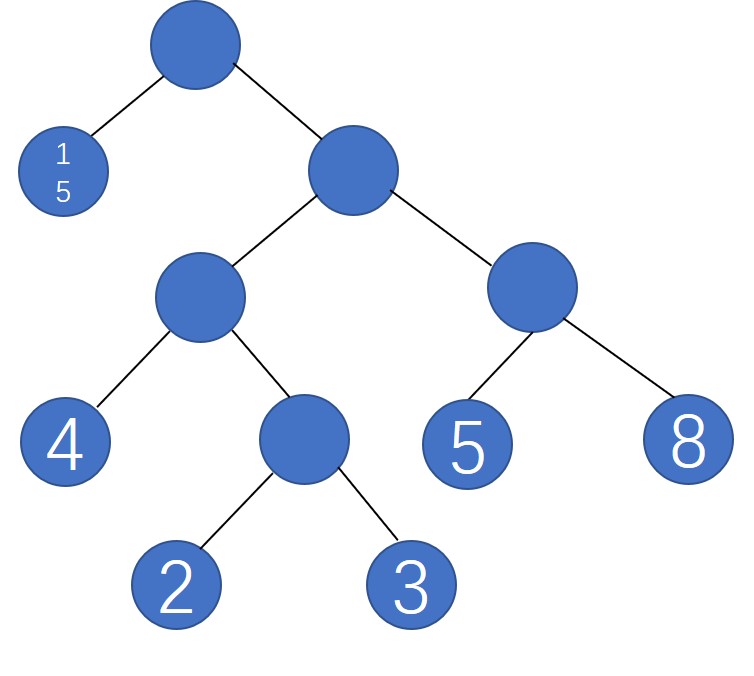哈夫曼树介绍 #
哈夫曼树也称为最优二叉树,给定n个权值作为n个叶子结点,构造一棵二叉树,若该树的带权路径长度达到最小,即为哈夫曼树

哈夫曼树中有这样几个名词需要了解:
- 路径:在一棵树中,一个结点到另一个结点之间的通路,称为路径
- 路径长度:在一条路径中,每经过一个结点,路径长度都要加1。例如在一棵树中,规定根结点所在层数为1层,那么从根结点到第i层结点的路径长度为i-1。上图中从根结点到结点5的路径长度为3
- 结点的权:给每一个结点赋予一个新的数值,被称为这个结点的权,也就是每个结点的值
- 结点的带权路径长度:指的是从根结点到该结点之间的路径长度与该结点的权的乘积。如结点5的带权路径长度为 3 * 5 = 15
哈夫曼树构建算法 #
在构建哈弗曼树时,要使树的带权路径长度最小,只需要遵循一个原则:权重越大的结点离树根越近。
可以按照下述步骤构建哈夫曼树:
- 首先,找出所有元素中权重最小的两个元素
- 以最小的两个元素为子结点构建二叉树,则构建的二叉树的父结点的权重为两个子结点之和
- 剩下的元素和新构建的的父结点中选出权重最小的两个节点
进行第2步操作
以此类推,直至最后合成一个二叉树就是哈夫曼树
树的构造 #
哈夫曼树中的权即是结点的值,除外,还有左子树和右子树:
class BinaryTree:
def __init__(self, name, weight):
self.name = name
self.weight = weight
self.left = None
self.right = None
哈夫曼树的构建 #
先获取最小的两个结点,然后构造以此两结点为子结点的树,根结点为子结点的权值和
def makeHuffman(source):
m2, name = getMin2(source)
print(m2[0].name, m2[1].name)
left = m2[0]
right = m2[1]
sumLR = left.weight + right.weight
father = BinaryTree(None, sumLR)
father.left = left
father.right = right
if name == []:
return father
name.append(father)
return makeHuffman(name)
完整实现 #
from collections import deque
class BinaryTree:
def __init__(self, name, weight):
self.name = name
self.weight = weight
self.left = None
self.right = None
def getMin2(li):
# 定义获取列表中权重最小的两个结点:
result = [BinaryTree(None, float('inf')), BinaryTree(None, float('inf'))]
list_new = []
for i in range(len(li)):
if li[i].weight < result[0].weight:
if result[1].weight != float('inf'):
list_new.append(result[1])
result[0], result[1] = li[i], result[0]
elif li[i].weight < result[1].weight:
if result[1].weight != float('inf'):
list_new.append(result[1])
result[1] = li[i]
else:
list_new.append(li[i])
return result, list_new
def makeHuffman(source):
m2, name = getMin2(source)
print(m2[0].name, m2[1].name)
left = m2[0]
right = m2[1]
sumLR = left.weight + right.weight
father = BinaryTree(None, sumLR)
father.left = left
father.right = right
if name == []:
return father
name.append(father)
return makeHuffman(name)
def breadthFirst(gen, index=0, nextGen=[], result=[]):
# 遍历输出结果
if type(gen) == BinaryTree:
gen = [gen]
result.append((gen[index].name, gen[index].weight))
if gen[index].left != None:
nextGen.append(gen[index].left)
if gen[index].right != None:
nextGen.append(gen[index].right)
if index == len(gen)-1:
if nextGen == []:
return
else:
gen = nextGen
nextGen = []
index = 0
else:
index += 1
breadthFirst(gen, index, nextGen, result)
return result
sourceData = [('a', 5), ('b', 4), ('c', 3), ('d', 8), ('f', 15), ('g', 2)]
sourceData = [BinaryTree(x[0], x[1]) for x in sourceData]
huffman = makeHuffman(sourceData)
print(breadthFirst(huffman))
哈夫曼编码 #
如果将访问左节点定义为0,访问右节点定义为1,那么访问某个结点所形成的二进制码就称为哈夫曼编码。例如图中的5,对应
哈夫曼编码为110,而结点8的哈夫曼编码为111。



